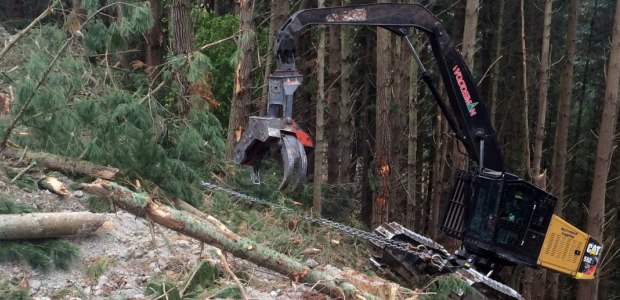
Oregon OSHA Revises Guidelines for Tethered Logging
Employers intending to use winch- or cable-assisted systems for steep slope logging must ensure that the harvesting machine was specified by its manufacturer for operation on slopes of more than 40 or 50 percent or seek a research variance before using the harvesting machine above its slope limit with a tethered system.
Oregon OSHA on March 21 posted a summary of its revised guidelines for using tethered logging systems (winch-assisted, cable-assisted, traction-assisted, etc.), which enable ground-based timber harvesting machines to operate on slopes of more than 50 percent. Oregon's 437-007-0935(1)(b) and (c) require that these machines may be operated used on slopes up to 40 percent only, or 50 percent if the machine was designed for steep slopes; general operation beyond their applicable slope limit is permitted only when specified by the machine manufacturer.
The required limits are:
- Rubber-tired skidders: 30 percent
- Crawler tractors, tracked feller bunchers, tracked excavators, and loaders: 40 percent
- Other forestry equipment designed for steep slopes: 50 percent
Employers who plan to use tethered logging systems in Oregon must ensure that the harvesting machine to be tethered was specified by its manufacturer for operation on slopes of more than 40 or 50 percent, as required, or else apply for and be granted a research variance before using the harvesting machine above its slope limit with a tethered logging system. Oregon OSHA's summary said its decision to grant research variances from 437-007-0935(1)(b) or (c) "is to support the use of new technology that could replace dangerous tree falling and timber transporting operations by workers on the ground with operators in machines with protective cabs meeting the requirements of 437-007-0775. Approved research variances will also provide a means of collecting relevant safety data until Division 7 (Forest Activities) rules can address these newly introduced technologies."
The agency will consider these criteria for research variance approval:
- Harvesting machines used with an operator in a tethered logging system must be manufactured on or after July 1, 2004, and meet the protective structure requirements covered under 437-007-0775.
- The tethered logging system must be designed, constructed, and strictly used for tethered logging applications.
- Tethered logging systems must be operated, inspected, and maintained according to the manufacturer’s recommendations and specifications.
- Tethered logging operations must meet all applicable general Division 7 (Forest Activities) requirements: working alone, emergency plans, supervision, etc.
- Tethered logging operations must be planned by the operator and the competent person on how to safely operate on slopes more than 50 percent, taking into consideration the experience of the operator; limitations of the machine and soil conditions; direction of travel; requirements for turning the machine on slopes; weather; load sizes; method and adequacy of anchorage; and any other adverse conditions.
- Tethered logging system operators must have adequate experience in safely operating the system on slopes less than 50 percent prior to operating the system on slopes more than 50 percent.
The summary also lists what the variance application must specify, including the criteria for replacing the tether line and ensuring that tensions do not exceed 1/3 of breaking strength to maintain a 3:1 safety factor or greater.
Twice a year, employers obtaining a variance must provide data to Oregon OSHA that identifies their safety, health, and ergonomic issues; their recordable injuries incurred during tethered logging operations and comparative data for any hand felling and cable logging injuries that were incurred at the same work site; records maintained on tether line inspections; the number of trees cut or volume of timber transported; and hours of work by the operator actually operating the machine on slopes greater than 50 percent (daily & weekly).
To obtain a variance request form, contact Tom Bozicevic at 503-947-7431 or [email protected].